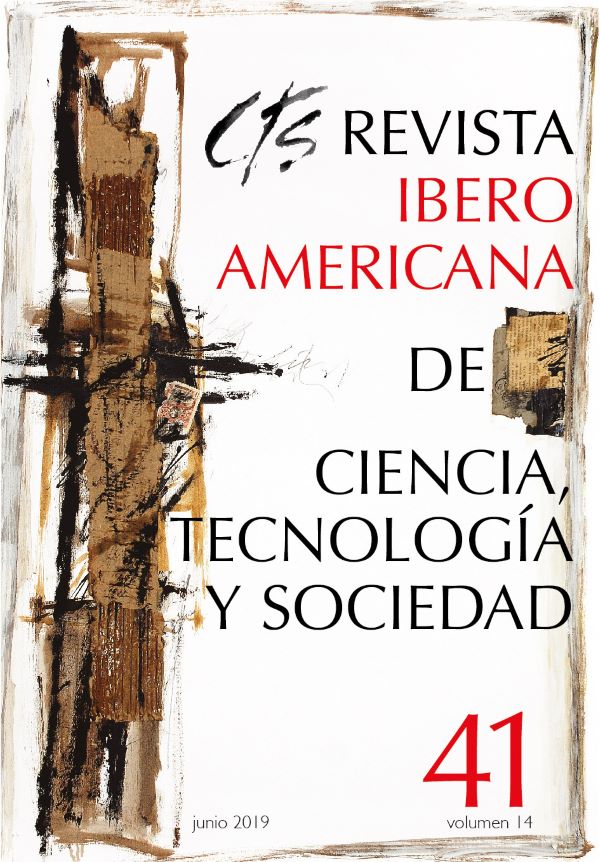Engineering and Social Concern: Towards New Practices
Keywords:
technological determinism, frugal innovation, collective action, STS teaching, engineeringAbstract
Based on the observation that currently there is identification between technological irreversibility and technological inevitability —an identification that denies the possibility of constructing alternatives to what already exists—, this paper argues that this framework is not accurate and that such a construction requires a reflexive discussion regarding new practices in engineering education. This is essential to prompt social concern among science and technology students and face the challenges of climate change, inequality and the antidemocratic drift in the application of information and communication technologies.Downloads
References
ABROL, D. (2014): “Pro-poor Innovation Making, Knowledge Production, and technology Implementation for Rural Areas: Lessons from the Indian Experience”, Innovation in India. Combining Economic Growth with Inclusive Development, Nueva Delhi, Cambridge University Press, pp. 337-378.
ANDERSEN, E. (1995): Feasibility Study in New Awareness Initiatives, Copenhagen, Danish Board Of Technology.
ASIMOV, I. (1974): Los propios dioses, Madrid, Bruguera.
BRYNJOLFSSON, E. y MC AFEE, A. (2014): The Second Machine Age. Work, Progress, and Prosperity in a Time of Brilliant Technologies, Nueva York, Norton and Co.
DAVID, P. (1985) “Clio and the Economics of QWERTY”, The American Economic Review, vol. 75, n° 2, pp. 332-337.
DERTOUZOS, M. L., LESTER, R. K., SOLOW, R. M. y MIT COMMISSION ON INDUSTRIAL PRODUCTIVITY (1989): Made in America: Regaining the Productive Edge, Cambridge, MIT Press.
EHN, P. (1988): Work-Oriented Design of Computer Artifacts, Umea University. Disponible en: https://www.diva-portal.org/smash/get/diva2:580037/FULLTEXT02.pdf. Consultado el 10 de enero de 2019.
GEIDO, D., FAILACHE, H. y SIMINI, F. (2007): “BiliLED fototerapia neonatal de bajo costo: del prototipo a la producción industrial”, Proceedings of the XVI Congreso Argentino de Bioingeniería, V Jornadas de Ingeniería Clínica, San Juan, Argentina. Disponible en: http://www.nib.fmed.edu.uy/bililed_sabi.pdf. Consultado el 21 de abril de 2019.
GERTH, H. y WRIGHT, C. (1991): From Max Weber, Oxford, Routledge.
GUARGA, R. (2012): “Jornada Técnica: La tecnología SIS aplicada al control y prevención del riesgo de heladas en Uruguay”, INIA Las Brujas. Disponible en: http://www.ainfo.inia.uy/digital/bitstream/item/3740/1/SIS41031163325667.pdf. Consultado el 21 de abril de 2019.
HOARE, C. (1981): “The 1980 ACM Turing Award Lecture: The Emperor Old Clothes”, Communications of the ACM, vol. 24, n° 2, pp. 75-83.
KAMP, L. (2010): “The Development of Wind Power in the Netherlands and Denmark”, en P. Strachan, D. Toke y D. Lal (eds.): Wind Power and Power Politics. International Perspectives, Nueva York, Palgrave, pp. 183-202.
LUNDVALL, B. Å. (1985): “Product Innovation and User-Producer Interaction”, Industrial Development Research Series, n° 31, Aalborg University Press.
MISA, T. (1994): “Retrieving Sociotechnical Change from Technological Determinism”, en M. R. Smith y L. Marx (eds.): Does Technology Drive History? The dilema of technological determinism, Nueva York, The MIT Press, pp. 115-142.
MISA, T. (2011): Leonardo to the Internet. Technology and Culture From The Renaissance To The Present, Baltimore, The John Hopkins University Press.
NOBLE. D. (1979): “Social choice in machine design: the case of numerically controlled machine tools”, in A. Zimbalist (ed.): Case Studies on the labour process, Nueva York, Monthly Review Press, pp. 18-50.
METROPOLIS, N., HOWLETT, J. y ROTA, G. C. (1985): A History of Computing in the Twentieth Century, Nueva York, Academic Press.
OBRAS SANITARIAS DEL ESTADO (s/f): “UPA: planta compacta y transportable para la potabilización de agua”. Disponible en: http://www.ose.com.uy/descargas/publicaciones/Brochure_upas/upa.pdf. Consultado el 21 de abril de 2019.
OSTROM, E. (1996): “Crossing the Great Divide: Coproduction, Synergy, and Development”, World Development, vol. 24, n° 6, pp. 1073-1087.
PIKETTY, T. (2014): Capital in the XXI Century, Cambridge, Harvard University Press.
RHODES, R. (2005): Dark Sun. The making of the hydrogen bomb, Nueva York, Simon & Schuster.
ROGERS, E. M. (2003): Diffusion of Innovations, Nueva York, Free Press.
SCHOT, J. (2003): “The Contested Rise of a Modernist Technology Politics”, en T. Misa, P. Brey y A. Feenberg (eds.): Modernity and Technology, Cambridge, The MIT Press, pp. 257-278.
SCHOT, J. y RIP, A. (1997): “The past and future of constructive technology assessment”, Technological Forecasting and Social Change, vol. 54, n° 2–3, pp. 251-268.
SCHUMACHER, E. (1984): Lo pequeño es hermoso, Madrid, Hermann Blume.
SEN, A. (2000): “Social Exclusion: Concept, Application and Scrutiny”, Social Development Papers, n° 1, Asian Development Bank.
TIKU, N. (2018): “The year tech workers realized they were workers”, WIRED. Disponible en: https://www.wired.com/story/why-hotel-workers-strike-reverberated-through-tech/. Consultado el 10 de enero de 2019.
VON HIPPEL, E. (1998): The Sources of Innovation, Nueva York, Oxford University Press.
WEIZENBAUM, J. (1976): Computer Power and Human Reason. From Judgement to Calculation, San Francisco, Freeman and Co.
ZUBOFF, S. (2019): The Age of Surveillance Capitalism: The Fight for a Human Future at the New Frontier of Power, Nueva York, Public Affairs.
Downloads
Published
How to Cite
Issue
Section
License
All CTS's issues and academic articles are under a CC-BY license.
Since 2007, CTS has provided open and free access to all its contents, including the complete archive of its quarterly edition and the different products presented in its electronic platform. This decision is based on the belief that offering free access to published materials helps to build a greater and better exchange of knowledge.
In turn, for the quarterly edition, CTS allows institutional and thematic repositories, as well as personal web pages, to self-archive articles in their post-print or editorial version, immediately after the publication of the final version of each issue and under the condition that a link to the original source will be incorporated into the self-archive.











